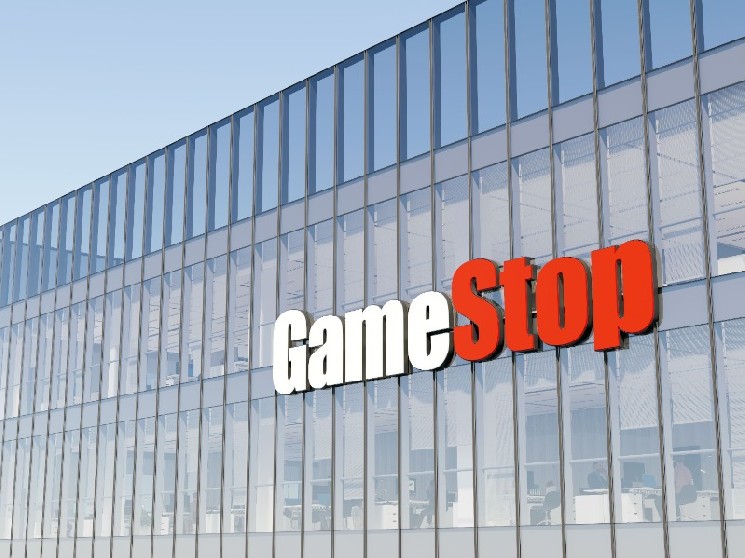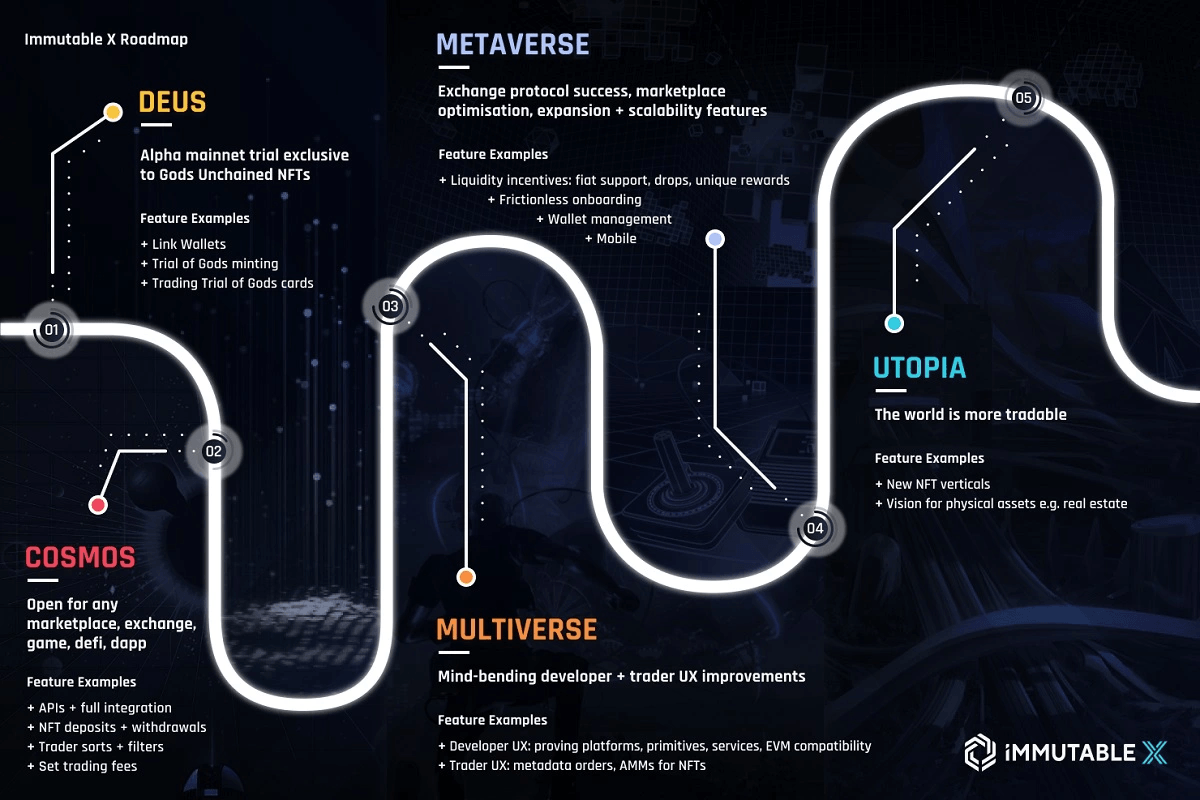GameStop’s NFT Marketplace Clears $5M in 1 Week: What’s to Come

GameStop’s NFT marketplace crossed the $5 million trading volume milestone on Monday. At a time when the overall NFT market declined by -60% in Q3 from already decimated Q2, is this the beginning of a trend?
It turns out, there is a secret ingredient to GameStop marketplace success – blockchain gaming powered by ImmutableX.
What is ImmutableX?
Although ImmutableX (IMX) became popular after TikTok picked it for its Top Moments NFTs, the network already had a good reputation. The Australian team behind NFT trading card game Gods Unchained stepped up beyond blockchain gaming into platform development.

ImmutableX has an ambitious goal – to become the Amazon of blockchain gaming and NFT marketplaces. Image credit: ImmutableX
James Ferguson, Robbie Ferguson, and Alex Connolly launched ImmutableX in 2018 as a super cheap (near-zero gas fee) and fast protocol to process NFT transactions. As Ethereum’s layer 2 scaling network, ImmutableX can handle the bulk of blockchain assets, such as either ERC-20 (regular crypto tokens) or ERC-721 tokens (NFTs).
In short, ImmutableX is focused on making blockchain gaming accessible for both players and game developers. Because blockchain gaming revolves around NFTs, as tradable and playable in-game assets, ImmutableX made it convenient and affordable to do so without getting drained by ETH gas fees.
GameStop’s Partnership with ImmutableX
After having announced its partnership with GameStop in February, the ImmutableX-powered NFT marketplace finally went online on October 31st. Effectively, this is GameStop’s entry into the growing Web3 ecosystem, dominated by blockchain games/metaverse.
Since then, in just a single week, GameStop traded over $5 million worth of volume on IMX. Overall, ImmutableX minted over 52 million NFTs this year, facilitating over 8.9 million NFT trades. Although Axie Infinity paved the road for blockchain gaming, here are some of the rising stars available, or soon to be, on GameStop:
- Gods Unchained – Equal in production value to Blizzard’s Hearthstone, this is a turn-based, fantasy-themed, digital collectible card game.
- Illuvium – Still in beta, much is expected of this AAA sci-fi adventure, monetized by ILV token. Amid high speculation, once the trailer was released, ILV reached an incredible $1,844 all-time high in December 2021.
- Guild of Guardians – Scheduled to be released in H2 2023, this isometric action RPG is aiming to be Web3’s Diablo.
- Ember Swords – Known for being created by veteran game developers from Bright Star Studios, Ember Swords is a social sandbox MMORPG. Just like Yuga Labs released Otherdeed for the upcoming Otherside, Bright released their ES land NFTs, holding at $1.36 million market cap.
- Bitverse – Also in beta, this 8/16-bit game is actually a collection of games, starting with the main ones upon release: RPG, battle royale, and endless runner.
Why is GameStop Becoming a Web3 Company?
With its non-custodial browser wallet, GameStop is going full Web3. The gambit is simple. According to GlobalData forecast, the metaverse market size should reach $996.42 billion by 2030. Even without accounting for Web3 games, in-game spending by 2025 should reach 74.4 billion.
For gamers, this represents a unique opportunity that hasn’t existed before. Outside of e-sports and Twitch streaming, there was no way to have a steady income directly from gaming. After all, traditional games have their marketplaces locked to accounts.
Even if one were to spend $10,000 on those in-game assets, they remain untradeable and valuable only to the account holder. Blockchain gaming flips that economy around, making all in-game assets publicly tradeable, from NFTs to native utility and governance tokens. In other words, Web3 games transfer the in-game asset ownership to players.
What’s Next for GameStop
As the company’s next move, GameStop should partner with the FTX exchange. However, with a hot war brewing between Binance and FTX, there may be a change of plans. In fact, Binance just might acquire FTX altogether. In the meantime, GME stock has remained above negative returns in the last 30 days, at +1.18%.
Year-to-date, GME stock lost -32.87% of its value, now trading at $25.66 per share. This is a -239% decline from its all-time high of $86.88 in January 2021. Presently, GME open interest (OI) is higher than average, having increased by 2.1% on a daily basis, suggesting a continuation of its meme stock trading status.






 Bitcoin
Bitcoin  Ethereum
Ethereum  Tether
Tether  USDC
USDC  Dogecoin
Dogecoin  TRON
TRON  Cardano
Cardano  Bitcoin Cash
Bitcoin Cash  Chainlink
Chainlink  LEO Token
LEO Token  Stellar
Stellar  Hedera
Hedera  Litecoin
Litecoin  Monero
Monero  Dai
Dai  OKB
OKB  Cronos
Cronos  Ethereum Classic
Ethereum Classic  Gate
Gate  VeChain
VeChain  Cosmos Hub
Cosmos Hub  Algorand
Algorand  KuCoin
KuCoin  Stacks
Stacks  Tether Gold
Tether Gold  Zcash
Zcash  Theta Network
Theta Network  IOTA
IOTA  Tezos
Tezos  TrueUSD
TrueUSD  NEO
NEO  Polygon
Polygon  Ravencoin
Ravencoin  Decred
Decred  Dash
Dash  Zilliqa
Zilliqa  Qtum
Qtum  Synthetix Network
Synthetix Network  0x Protocol
0x Protocol  Basic Attention
Basic Attention  Siacoin
Siacoin  Holo
Holo  DigiByte
DigiByte  Nano
Nano  Enjin Coin
Enjin Coin  Status
Status  Ontology
Ontology  Hive
Hive  Waves
Waves  Lisk
Lisk  Pax Dollar
Pax Dollar  Steem
Steem  Numeraire
Numeraire  BUSD
BUSD  NEM
NEM  Huobi
Huobi  OMG Network
OMG Network  Bitcoin Gold
Bitcoin Gold  Ren
Ren  Bitcoin Diamond
Bitcoin Diamond  Augur
Augur  HUSD
HUSD